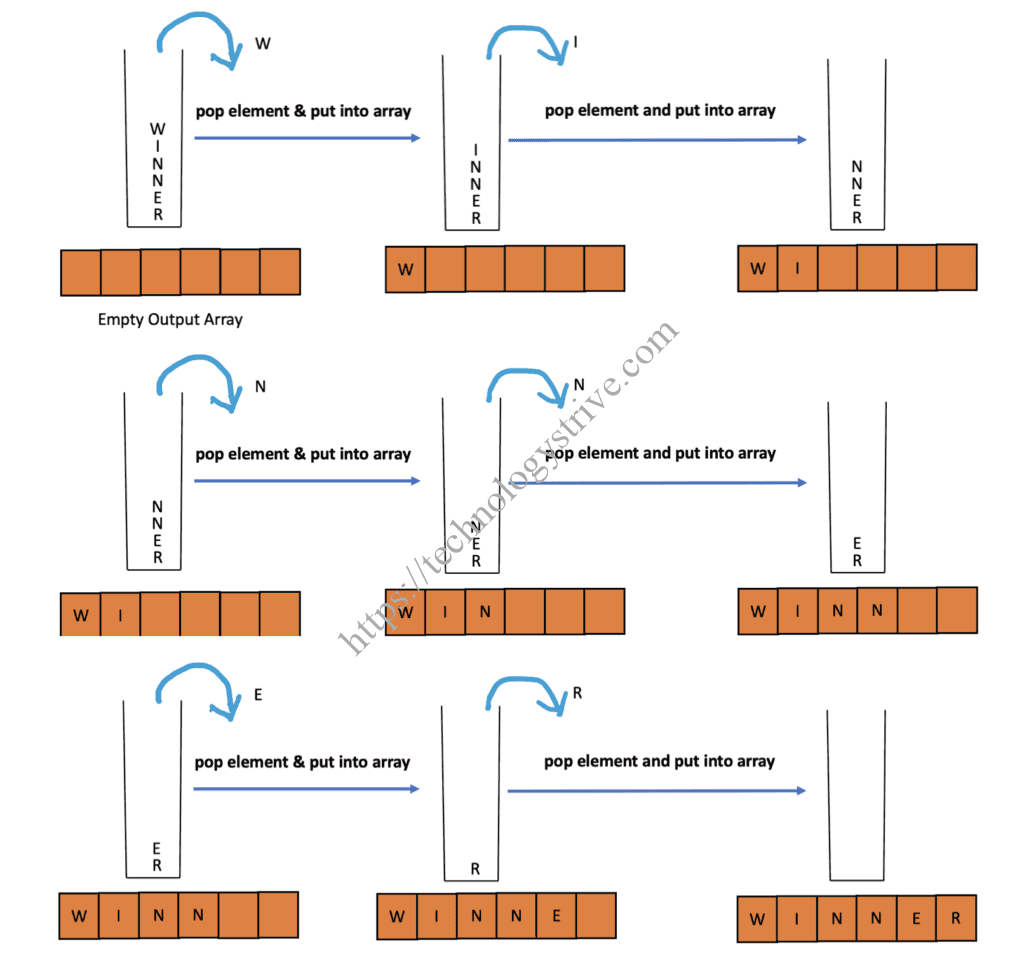
String Reverse Problem
Problem Statement
1Problem Description :2Given a String, return the reverse of the String.34Input: A String56Output: Return reverse of the given string
1Example 1 :23 Input : Strive4 Output: evirtS5 Explanation : evirtS is reverse of Strive
1Example 2 :23 Input : RENNIW4 Output: WINNER5 Explanation : WINNER is reverse of the string RENNIW
Solution Approaches
String reverse can be done using multiple approaches and below are the list of approaches for the given problem.
Using Stack Data Structure
Algorithm
1Input : A String23Step 1: Initialize a Stack, a char array (output) of length of size n (where n is length of the given string)45Step 2: Push all characters of the given string one by one67Step 3: Pop letters from stack and put into output array starting with 0 index89Step 4: convert output array into string and return
Example Dry Run
Input String : RENNIW
Step 1 :
- Create a Stack
- Create empty char array output
Step 2 :
Step 3 :
Step 4 :
- convert output array into a string and return
Output String : WINNER
Code Implementation
- Java
- Python
1import java.util.Stack;23public class StringReverseUsingStack {45 // method to reverse given input string6 public String reverse(String input){7 if(input == null){8 return null;9 }10 // Initialize stack and output array11 Stack<Character> stack = new Stack<>();12 char[] output = new char[input.length()];1314 // push letters of the given string one by one into the stack15 for(int i=0; i<input.length(); i++){16 stack.push(input.charAt(i));17 }1819 int i = 0;20 // pop letters from stack one by one and put into output array21 while (!stack.isEmpty()){22 Character ch = stack.pop();23 output[i++] = ch;24 }2526 // convert the output array into string and return the result27 return String.valueOf(output);28 }2930 public static void main(String[] args){31 StringReverseUsingStack obj = new StringReverseUsingStack();3233 // Example 1 :34 String input1 = "Strive" ;35 System.out.println(obj.reverse(input1));3637 // Example 2:38 String input2 = "RENNIW" ;39 System.out.println(obj.reverse(input2));40 }41}
Complexity Analysis
- Time Complexity : O(n) where n is the length of the string
- Space Complexity: O(n) as we are using stack data structure.
Using Two Pointer Technique
Prerequisite
Algorithm
1Input : A String23Step 1: Convert string into char array input and initialize two pointers i and j with 0 and n-1 (n is length of the array)45Step 2: Swap elements at place i and j67Step 3: Move i pointer one step ahead and j pointer one step behind89Step 4: Repeat step 1 until both i and j crosses with each other1011Step 5: Convert array into string and return12
Example Dry Run
Input String : RENNIW
Step 1 :
- convert string to a char array named input.
- initialize i = 0 and j = n-1 (5 for this example)
Step 2:
- swap input[i] and input[j]
Step 3:
- increment i with 1 and decrement j with 1 (i becomes i+1, j becomes j-1)
Step 4:
- repeat from step 1 and it gets terminated when i = 3 and j = 2.
Step 5:
- convert the final array into string and return the same.
Output String : WINNER
Java Implementation
1public class StringReverseUsingTwoPointerTechnique {23 public String reverse(String input) {4 if(input == null){5 return null;6 }7 return reverse(input.toCharArray());8 }910 private String reverse(char[] input) {11 // initialize i to 0 and j to last index12 int i = 0;13 int j = input.length-1;1415 // swap elements at 1 and j with each other16 // move start pointer i with one step ahead17 // and j with one step behind18 // continue same process until19 // both i and j crosses with each other20 while (i<j) {21 swap(input, i, j);22 i++;23 j--;24 }25 return String.valueOf(input);26 }2728 // method to swap elements29 private void swap(char[] input, int i, int j) {30 char temp = input[i];31 input[i] = input[j];32 input[j] = temp;33 }3435 // Driver Code36 public static void main(String[] args) {37 StringReverseUsingTwoPointerTechnique obj =38 new StringReverseUsingTwoPointerTechnique();3940 // Example 1 :41 String input1 = "Strive" ;42 System.out.println(obj.reverse(input1));4344 // Example 2:45 String input2 = "RENNIW" ;46 System.out.println(obj.reverse(input2));47 }48}
Complexity Analysis
- Time Complexity : O(n)
- Space Complexity: O(1)
Approaches Comparison
| Approach | Time Complexity | Space Complexity | Remarks |
|---|---|---|---|
| Using Stack | O(n) | O(n) | Extra Space is needed |
| Using Two Pointer Technique | O(n) | O(1) | No Extra Space |


